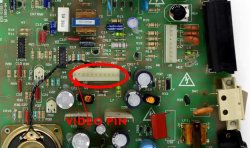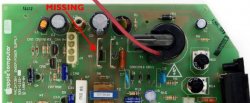Some update on my plus.
So, it's working the way I can turn it on. Actually no special lessons on that. As His Majesty MacTech68 said before - some of the tracks were in a pretty bad condition due to humidity and so. What was done:
1) All the electronic parts on video/analog boards checked - test passed and believe or not all seem to be fine
2) Minor yoke adjustment - didn't realy have much of the impact
3) Minor tracks cleanup (analog board) - only some of them got bad and those were cleaned, optically there is not all of that much of a difference, now all tracks pass the test with one restriction - it doesn't really mean that they may not go bad again. For such all the board would have to be totally reworked, which (in expert's opinion) did not make much sense.
The plus is back home and there is still much to do. I'll basically tell all of the story maybe y'all would have some suggestions. Guess would be better that way than just do sth bad to it
...
This much for nowI'll post pictures of warmed up working plus with system 1.1 on it (off the external drive) later.
OK. I can see you've had a lot of "fun" swapping the drives around and are determined to get it functional.
What I might get you to do, is to re-post the second half of your post (referring to the floppy drives) here:
https://forums.macrumors.com/threads/1354182/
There are some starting points there too.
As for the shaky video, I see one of 7 possibilities
1. A failing electrolytic capacitor which, once it is warm, behaves normally.
2. A dry/cracked solder joint
3. poor connectivity at the yoke connector itself
4. out of adjustment +5 volt rail.
5. a failing - but not yet failed - Flyback transformer
6. poor earth at the CRT mounting ear.
7. oxidization on adjustment potentiometers.
To test #2 and #3, you can try tapping the board with a suitable plastic "prodder". The OUTER plastic tube of a Bic Cristal would suffice - remove the innards of the pen first. You can use the tube to wiggle the yoke cables and tap/knock the solder side of the analog board whilst observing the screen.
Obviously, adjusting the +5 volt rail should be easy enough. Follow the directions in the pdf I posted earlier.
If that STILL doesn't reveal the problem, see if allowing the board to cool (a few hours in a cool area) causes the problem to occur and disappears once warm again. If it's reproducible every time, then this should be #1, and I would suspect the large 3.9uf capacitor on the top edge of the analog board, next to the horizontal width coil. These caps were later replaced by an 'Electronic Concepts' Low ESR Metalized Polycarbonate axial special order 5MC series capacitor P/N 5MC-9931K :
http://www.ecicaps.com/capacitors/f...carbonate-switch-mode-power-supply-capacitors
though a suitable replacement Low ESR, non-polar, 100V, 105degC, poly capacitor should be easily locatable by your expert if required.
As for #5, there isn't much you can do other than replace the transformer. they are resin potted, which means you can't repair them when they begin arcing internally.
For #6, which is rare but did occur on very early Mac 128Ks, there is a black wire which fastens to the top left mounting ear (viewed from the rear) of the CRT with a crimped eyelet. If the screw holding this is loose or (in the case of some early CRTs) an overspray paint covered the metal ear, this can cause an intermitted jitter and brightness. Cleaning and re-fitting this can help. DON'T OVERTIGHTEN the screw, as you can cross the thread in the front panel, which will make tightening impossible.
For #7 tapping the adjustment pots with the plastic prodding tool may reveal these as a cause.
That about sums up what I'm thinking, although there may be other 'unknown' causes, possibly even involving the motherboard. Your chosen expert may be able to assist with the above points if you're not feeling adventurous.
As always, take great care as these analog boards have numerous LEATHAL VOLTAGES exposed on the solder and component side.
Last edited:



